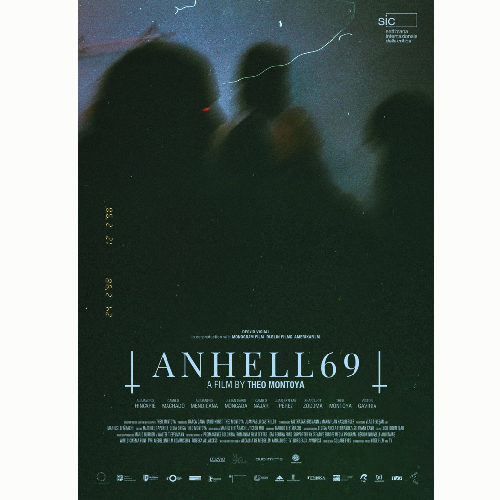
Anhell69 – documentary
Anhell69 is a personal, ethnographic documentary about Theo Montoya and his feature film project Anhell69. The documentary consists of a series of casting interviews with Montoya’s friends who were all set to star in the film, concept shots of the film, and scenes from their lives as a community. This group of men lives in Medellin, Colombia and the documentary aims to address their experiences there as members of the queer community as well as the concept for Montoya’s ghost story–which was never completed. The published summary for Anhell69 describes the young queer scene in Colombia being cast in a vampire movie when the star dies of a heroin overdose at age 21, but the documentary covers so much more than just these events tackling themes of protest, identity, life, death, liberation, love, connection, and nihilism.
There were a number of different levels that I felt this film operated on, I only hope I can address all of them in this review, but I will most certainly fall short of what it deserves. The film cut between Montoya describing his life in Colombia starting from childhood but mainly focusing on the last eight or so years, casting interviews from his Anhell69 project, and images of loss that Montoya created for the film. The way the casting interviews were set up throughout the film created a cohesive storyline for each of the men involved in Montoya’s life and their presence as time passed. Once Montoya laid bare one of his friend’s deaths, clips from their casting interview were no longer included in the film. This highlighted their presence in his life and the story he was weaving in a very poignant way for the audience. Shots of these people were still included in images of Montoya’s life as he continued his story, but we were no longer able to hear directly from the individuals, creating a striking sense of their loss. The images of loss that Montoya included were not solely focused on the loss of his friends, although that did feature heavily. There is a repeating shot in the film of a casket being transported in the back of a hearse. In most of the shots, the casket is obviously open, but shadowed so the person inside is hidden. This image of an invisible person follows many of Montoya’s descriptions of losing his friends or simply describing the state of war on the streets of Medellin giving the audience a moment of mourning before continuing with the story. At the end of the film, the hearse drives into the sunlight so we can see the figure in the casket which turns out to be Montoya himself showing his distinct loss of self that he experienced with each of the events in his story. This is further highlighted by a scene in which Montoya outlines multiple “deaths” that he has experienced–some by suicide or overdose as his friends did, some on the streets in a state of protest, but all a commentary on his position in society. This motif drives home his point about the state of queer Colombians living in Medellin and his experiences of grief and loss in his life.
I went into this film (during IDFA) expecting it to tell a trans story. My current research and reason for going to the film is about trans storytelling in different settings. On the surface, this film does not appear to be trans–all of the individuals in this group of friends present as young queer men and there is no mention of a transition for any of them. In fact, the closest they get to explicit experienced transness is one of them being a drag queen. But that is just on the surface. Montoya in his film making and each of his friends in their lives have taken “trans” from its status of being born in the wrong body and elevated it to a vision of gender without border, media without border, and life in a state of ambiguity that few cis people understand. My expectation of this being a trans story geared towards a cis audience was shattered repeatedly through each of the different layers Montoya presented. I loved the way this documentary explored and presented gender to the audience, though it did fit into one of the six trans scripts that are so common in media. This film was a powerful example of the “victim” script that highlights violence and discrimination against trans people. That being said, I do think that relegating this piece of media into that category is an incredibly privileged action because the trans experience in Colombia is so different from the trans experience in the Netherlands. I also think that because the main theme of the film is grief and loss rather than transness, this is perhaps not the most accurate description. I would highly recommend seeing this film regardless of your gender identity because it touches on many issues beyond the social and personal identities Montoya holds. If you are looking for something light, this film is not for you, but if you want something that will leave you thinking about it for days after, look no further.
**Use this link to tell me what you thought of the review:
